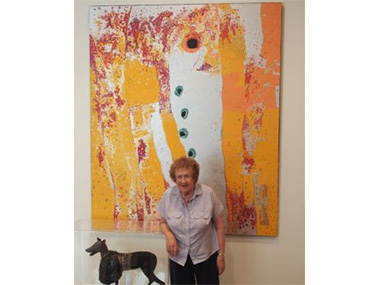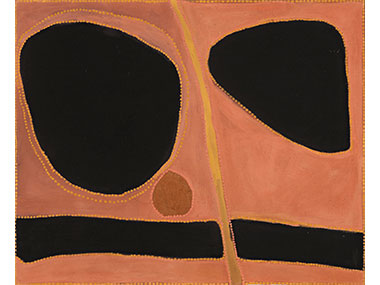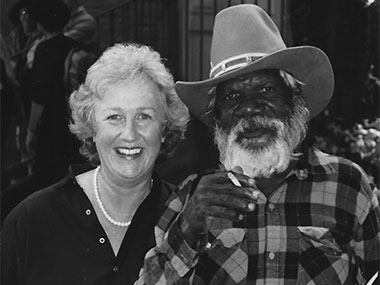A PARTING OF THE WAYS

Liz Laverty (and a Louise Weaver dog) stand with the Daniel Walbidi 2015 Telstra General Painting Award winner - not in the sale.
Posted by Jeremy Eccles | 04.04.17
Dates:
23.03.17
: 05.04.17
To own so much art that you can hold not one but three auction sales of it – the latest of more than 150 works - may seem a tad excessive. But any time spent with Liz Laverty – widow of the great pathologist Colin Laverty, with whom she built this collection of both Indigenous and non-Indigenous art – allows you to appreciate the pain she feels about downsizing a collection that is just too large for a person growing older to justify keeping to herself.
There are off-site storage costs, of course; there are grandchildren to educate; there's Laverty's own plan to downsize to Melbourne to be closer to her daughter; and there's definitely a sense that, despite publishing grand books appreciating the cream of the collection and a generous loan policy to public institutions, there's a selfishness involved in simply hanging on to some of the greatest works of art produced in the second half of the 20th Century in Australia.
For, although the Lavertys are most famously associated with their support for Aboriginal art from the point in 1988 when they first discovered it at the Brisbane Expo, they'd already built (and continued to build) a significant collection of Australian abstraction....Peter Upward, Ildiko Kovacs, Robert Klippel, Aida Tomescu, Ken Whisson and Dick Watkins are names that jump out of the Deutscher & Hackett catalogue for this April 5th sale. An in-your-face expressionist Tuckson hangs on the Laverty's living room wall when I visit; and there are probably more paintings by Australia's master of Pop Art, Richard Larter in this collection than in any other.
And then there's Carl Plate – not a name to conjure with, perhaps, like those above. But his 3.5 metre 'Graph Segments No 1' (1961) gets a whole page of catalogue essay to itself as a French-influenced model of abstraction for Australia that the Lavertys had bought in 1988, just as they were setting out on their Indigenous adventure. Included in that essay is reference to a late-life Michael Taylor purchase by Colin (and there are four of his under-valued abstract works in the auction) that had done wonders for the doctor's health. “The restorative power of abstract art”, he called it!
Photographs in the catalogue also make plain just how much healthy pleasure the Lavertys got from travelling to the remote communities where they could engage with the Aboriginal artists they bought and with the art coordinators who were so often the tie that linked the artists' best work to these reliable buyers. The picture of both Lavertys with a dolled-up Paddy Bedford is reflective of the fact that they'd bought just about his first painting on plywood to come to market in 1998 – and it's in the sale. A glowing Liz Laverty then stands beside Rover Thomas during his Venice Biennale triumph in 1990, a pioneering moment for Aboriginal art on the world scene. And Colin gets his moment in the sun posing quirkily beside Bill Robinson – both looking ready for a Robinson self-portrait.
That access to Paddy Bedford, star of the briefly-flowering Jirrawun Arts collective in Kununurra, came as a result of steady buying earlier from Melbourne gallerist, Tony Oliver – who went on to direct Jirrawun in the late 90s. He saw no intrinsic difference between this new mob and American stars such as Warhol and Philip Guston whom he'd been importing, and he saw every reason to charge similar prices to the same buyers. There have been suggestions that the artists' work was then directed by Oliver. But Liz Laverty is adamant that she and Col spent quite enough time watching those artists at work, camping out with them initially on the Bow River Station, to know who had painted what. And when you see the quality of the best works by Bedford, Rammey Ramsey, Rusty Peters and Phyllis Thomas in the auction, it's hard not to agree that Oliver may have opened up these artists to a world of art, but their individual voices shine through – especially in the 2007 Ramsey work, 'Warlawoon Country'.
But at a high estimated sale price of $15,000, it's not exactly on a par with Bill Robinson's 'Birkdale Farm' at $350,000 tops. Liz Laverty makes the point that stars like Rover Thomas, Paddy Bedford and Emily Kngwarreye are more of a match – her Rover in the sale having a $300,000 high estimate. And justifiably so for a really sophisticated work by the old Kimberley stockman – 'Djugamerri and Bolgumerri' (1991) – which refers back to the famous Goorir Goorir 'dream' that Rover had in the 70s pertaining to the return of a dead relative's spirit to her Gija Country via two sacred hills that linked desert songlines with The Kimberley where so many desert tribespeople (including Rover) had migrated.
Interestingly, that Rover doesn't have the provenance of the art centre at Waringarri which was operating in 1991, but was sourced from the private dealer in Perth, Mary Macha, who'd 'discovered' the artist, and flew him down to paint in her garage. Otherwise, the Lavertys were firm in their sticking to ethical buying only from Aboriginal art centres. So Liz Laverty admits to being confused by discovering that those ethics went out of the window when the Sotheby's auction house declared that Macha was the only acceptable source of Rover's art – not on ethical grounds but on the issue of sheer quality. Hypocrisy? And oddly inconsistent with the subsequent boycott of the great Tommy Watson's art when he chose to work for a private dealer rather than an art centre.
While the Lavertys undoubtedly had multiples of those East Kimberley artists' works on canvas – as they did with other art centres where they maintained long-term relationships such as Balgo and Bidyadanga – I wondered about their appreciation for Aboriginal barks. “Well I think we spent as much time at Maningrida with (co-ordinator) Apolline Kohen as anywhere”, Liz recalled, “and they've (the auctioneers) convinced me into parting with two of my last four Mawurndjuls – one early, one late – which is so sad”.
Even harder, in a group of decent East Arnhemland barks from Yirrkala, was the offering of a work by the relatively unknown Mathulu Munyarryun. A photo shows a small man quite dominated by his artwork – twice his size. Munyarryun's lack of prominence almost certainly arises from the seriousness with which he takes his culture – this work only being painted because there'd been a reconciliation between the Djapu clan and his own Wangurri, coinciding with the return of a historic message stick to the community by Governor-General Bill Deane. An art flowering resulted and this work's delivery to the Buklu Larrngay art centre coincided with a Laverty visit. But its sale could only be completed with a visit to Wangurri land and a telling of its story on Country.
“That sort of history makes a work terribly hard to sell”, admitted Liz.
Others are easier - it emerging that Liz finds it somewhat less emotional to dispose of works that were clearly Colin's preference than her own! A non-Indigenous text work, for instance, was definitely his choice, she insisted. And there's an Aboriginal artist with one work in the sale described by Liz “as a fairly ordinary work, which must have been Colin's choice!” - though she retains three by the same artist she clearly had more say in buying. “But I can't just give them things I've grown tired of – there has to be plenty of works worth selling”.
And of course, an artwork with the provenance of the Collection of Colin & Elizabeth Laverty has to have a premium on it. And there are some pretty nice offerings at $3 or $4000
URL: http://www.deutscherandhackett.com/48-laverty-collection-part-iii
Share this:
»  del.icio.us
»
del.icio.us
»  Digg it
»
Digg it
»  reddit
»
reddit
»  Google
»
Google
»  StumbleUpon
»
StumbleUpon
»  Technorati
»
Technorati
»  Facebook
Facebook
Contact Details

The Rover Thomas masterwork, 'Djugamerri and Bolgumerri' (1991) which is in the 3rd Laverty Collection sale

A radiant Liz Laverty in Venice with Rover Thomas in 1990.
Further Research
Artists: Emily Kngwarreye | John Mawurndjul | Mathulu Munyarryun | Paddy Bedford | Phyllis Thomas | Rammey Ramsey | Rover Thomas | Rusty Peters | Tommy Watson
News Tags: Colin Laverty | Deutscher & Hackett | Jeremy Eccles | Liz Laverty | Mary Macha | The Laverty Collection | Tony Oliver
News Categories: Auction | Australia | Blog | Event | Exhibition | Feature | Industry | News
Exhibition Archive
- 10.10.17 | TARNANTHI 2017
- 11.08.17 | Natsiaas 2017
- 20.07.17 | APY ART DOMINATES THE WYNNE
- 17.07.17 | Anangu Artist Wins $100,000 Prize
- 14.07.17 | The End of AAMU
- 11.07.17 | ART ACROSS THE COUNTRY
- 11.07.17 | TARNANTHI IN OCTOBER
- 05.07.17 | TJUNGUṈUTJA - from having come together
- 13.06.17 | Ghost-Nets Straddle the World
- 07.06.17 | Grayson Perry Going Indigenous?
- 05.06.17 | Barks Bigger than Ben Hur
- 27.05.17 | NGA QUINQUENNIAL 2017
- 21.05.17 | Blak Douglas Finds Home at the NGA
- 21.05.17 | BRIAN ROBINSON WINS HAZELHURST WOP
- 18.05.17 | PARRTJIMA 2.0
Advertising

